QTR-8RC Reflectance Sensor Array
Available with a lead time
Expect dispatch between Jan 09 and Jan 12
Quantity Discounts:
- 10+ $20.29 (exc GST)
- 25+ $19.65 (exc GST)
Note: The QTR-8RC reflectance sensor array requires digital I/O lines to take readings. The similar QTR-8A reflectance sensor array is available with analog outputs, and the reflectance sensor is available individually as a QTR-1RC reflectance sensor or QTR-1A reflectance sensor.
 |
Functional Description
The QTR-8RC reflectance sensor array is intended as a line sensor, but it can be used as a general-purpose proximity or reflectance sensor. The module is a convenient carrier for eight IR emitter and receiver (phototransistor) pairs evenly spaced at intervals of 0.375" (9.525 mm). To use a sensor, you must first charge the output node by applying a voltage to its OUT pin. You can then read the reflectance by withdrawing that externally applied voltage on the OUT pin and timing how long it takes the output voltage to decay due to the integrated phototransistor. Shorter decay time is an indication of greater reflection. This measurement approach has several advantages, especially when coupled with the ability of the QTR-8RC module to turn off LED power:
- No analog-to-digital converter (ADC) is required
- Improved sensitivity over voltage-divider analog output
- Parallel reading of multiple sensors is possible with most microcontrollers
- Parallel reading allows optimized use of LED power enable option
The outputs are all independent, but the LEDs are arranged in pairs to halve current consumption. The LEDs are controlled by a MOSFET with a gate normally pulled high, allowing the LEDs to be turned off by setting the MOSFET gate to a low voltage. Turning the LEDs off might be advantageous for limiting power consumption when the sensors are not in use or for varying the effective brightness of the LEDs through PWM control.
This sensor was designed to be used with the board parallel to the surface being sensed.
The LED current-limiting resistors for 5 V operation are arranged in two stages; this allows a simple bypass of one stage to enable operation at 3.3 V. The LED current is approximately 20–25 mA, making the total board consumption just under 100 mA. The schematic diagram of the module is shown below:
 |
For a similar array with three sensors, consider Pololu's QTR-3RC reflectance sensor array. The sensors on the QTR-8RC are also available individually as the QTR-1RC reflectance sensor, and the QTR-L-1RC is an alternative designed to be used with the board perpendicular to the surface.
 |
QTR sensor size comparison. Top row: QTRX-HD-07, QTR-HD-07; middle row: QTR-3, QTR-1, QTR-L-1; bottom row: QTR-8. |
|---|
Specifications
- Dimensions: 2.95" x 0.5" x 0.125" (without header pins installed)
- Operating voltage: 3.3-5.0 V
- Supply current: 100 mA
- Output format: 8 digital I/O-compatible signals that can be read as a timed high pulse
- Optimal sensing distance: 0.125" (3 mm)
- Maximum recommended sensing distance: 0.375" (9.5 mm)
- Weight without header pins: 0.11 oz (3.09 g)
 |
QTR-1RC output (yellow) when 1/8" above a black line and microcontroller timing of that output (blue). |
|---|
Interfacing the QTR-8RC Outputs to Digital I/O Lines
The QTR-8RC module has eight identical sensor outputs that, like the Parallax QTI, require a digital I/O line capable of driving the output line high and then measuring the time for the output voltage to decay. The typical sequence for reading a sensor is:
- Turn on IR LEDs (optional).
- Set the I/O line to an output and drive it high.
- Allow at least 10 µs for the sensor output to rise.
- Make the I/O line an input (high impedance).
- Measure the time for the voltage to decay by waiting for the I/O line to go low.
- Turn off IR LEDs (optional).
These steps can typically be executed in parallel on multiple I/O lines.
With a strong reflectance, the decay time can be as low as several dozen microseconds; with no reflectance, the decay time can be up to a few milliseconds. The exact time of the decay depends on your microcontroller’s I/O line characteristics. Meaningful results can be available within 1 ms in typical cases (i.e. when not trying to measure subtle differences in low-reflectance scenarios), allowing up to 1 kHz sampling of all 8 sensors. If lower-frequency sampling is sufficient, substantial power savings can be realized by turning off the LEDs. For example, if a 100 Hz sampling rate is acceptable, the LEDs can be off 90% of the time, lowering average current consumption from 100 mA to 10 mA.
Pololu's Pololu AVR library provides functions that make it easy to use these sensors with Pololu's Orangutan robot controllers; please see the QTR Reflectance Sensors section of Pololu's library command reference for more information. Pololu also have a Arduino library for these sensors.
Breaking the Module in Two
If you don’t need or cannot fit all eight sensors, you can break off two sensors and still use all 8 sensors as two separate modules, as shown below. The PCB can be scored from both sides along the perforation and then bent until it snaps apart. Each of the two resulting pieces will function as an independent line sensor.
 |
Included Components
This module ships with a 25-pin 0.1" header strip and a 100 Ohm through-hole resistor as shown below.
 |
You can break the header strip into smaller pieces and solder them onto your reflectance sensor array as desired, or you can solder wires directly to the unit or use a right-angle header strip for a more compact installation. The pins on the module are arranged so that they can all be accessed using either an 11×1 strip or an 8×2 strip.
The resistor is required to make the two-sensor array functional after the original eight-sensor array is broken into two pieces. This resistor is only needed once the board has been broken.
 |
Solder the included resistor to the 2-sensor array piece as shown to make the separated piece functional. |
|---|
How it works in detail
For more information about how this sensor works, see the “How it works in detail” section of the QTR-1RC product page.
People often buy this product together with:
 | TB6612FNG Dual Motor Driver Carrier |
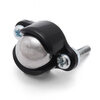 | Pololu Ball Caster with 3/8" Metal Ball |
 | QTR-8A Reflectance Sensor Array |
Identifying markings
| PCB dev codes: | irs02a1 |
|---|
Notes:
Documentation and other information
-
QTR-8A and QTR-8RC Reflectance Sensor Array User’s Guide (Printable PDF)
User’s guide for the QTR-8A reflectance sensor array.
-
Pololu QTR Reflectance Sensor Application Note (Printable PDF)
Information about using the Pololu QTR reflectance sensors, including differences between A-type and RC-type sensors and sample oscilloscope screen captures of sensor outputs.
-
Pololu AVR C/C++ Library User’s Guide (Printable PDF)
Information about installing and using the C/C++ libraries provided for use with Pololu products.
-
Pololu AVR Library Command Reference (Printable PDF)
A reference to commands provided in the Pololu C/C++ and Arduino libraries for the AVR.
-
Building Line Following and Line Maze Courses (Printable PDF)
Step-by-step instructions for building your own line-following courses.
File downloads
-
Datasheet for Fairchild’s QRE1113GR reflective object sensor (202k pdf)
This is the sensor that Pololu initially used in the Pololu QTR reflectance sensors, but Pololu have since switched to a similar generic unit that has slightly longer range.
-
QTR-8x Reflectance Sensor Array drill guide (35k dxf)
This DXF drawing shows the locations of all of the board’s holes.
-
Dimension diagram of the QTR-8x Reflectance Sensor Array (198k pdf)
-
Guide utilisateur du senseur QTR (suiveur de ligne) (1MB pdf)
Un guide utiliser et exploiter un senseur QTR (détecteur de ligne) (version 0.1). Note: This French translation of Pololu's QTR sensor documentation was made by Pololu's distributor MCHobby.
Recommended links
-
Matthew Phillipps ported Pololu's Arduino Library for the Pololu QTR Reflectance Sensors to the mbed platform. The Arduino library is designed to work with Pololu QTR reflectance sensors, so the mbed library should too, but Matthew points out he only tested it with the analog sensors. This library was not written and is not maintained by Pololu.
-
Arduino library for the Pololu QTR Reflectance Sensors
This library for Arduino makes it easy to interface with Pololu QTR Reflectance Sensors.
Exact shipping can be calculated on the view cart page (no login required).
Products that weigh more than 0.5 KG may cost more than what's shown (for example, test equipment, machines, >500mL liquids, etc).
We deliver Australia-wide with these options (depends on the final destination - you can get a quote on the view cart page):
- $3+ for Stamped Mail (typically 10+ business days, not tracked, only available on selected small items)
- $7+ for Standard Post (typically 6+ business days, tracked)
- $11+ for Express Post (typically 2+ business days, tracked)
- Pickup - Free! Only available to customers who live in the Newcastle region (must order online and only pickup after we email to notify you the order is ready). Orders placed after 2PM may not be ready until the following business day.
Non-metro addresses in WA, NT, SA & TAS can take 2+ days in addition to the above information.
Some batteries (such as LiPo) can't be shipped by Air. During checkout, Express Post and International Methods will not be an option if you have that type of battery in your shopping cart.
International Orders - the following rates are for New Zealand and will vary for other countries:
- $12+ for Pack and Track (3+ days, tracked)
- $16+ for Express International (2-5 days, tracked)
If you order lots of gear, the postage amount will increase based on the weight of your order.
Our physical address (here's a PDF which includes other key business details):
40 Aruma Place
Cardiff
NSW, 2285
Australia
Take a look at our customer service page if you have other questions such as "do we do purchase orders" (yes!) or "are prices GST inclusive" (yes they are!). We're here to help - get in touch with us to talk shop.
Have a product question? We're here to help!
Videos
View AllGuides
The Maker Revolution
Getting Hands-on with Sensors
Projects
WhyzaGC - Feather ESP32 addon to the MightyOhm Gieger Counter
Makers love reviews as much as you do, please follow this link to review the products you have purchased.

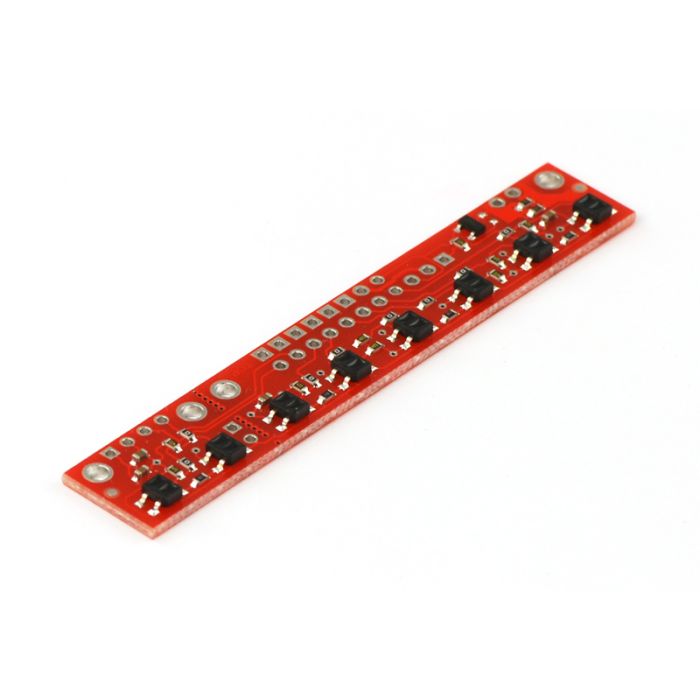

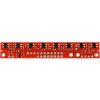
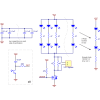











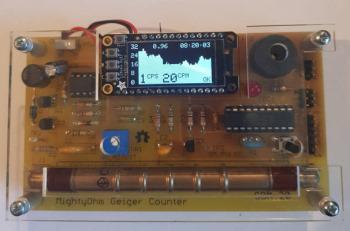

Product Comments